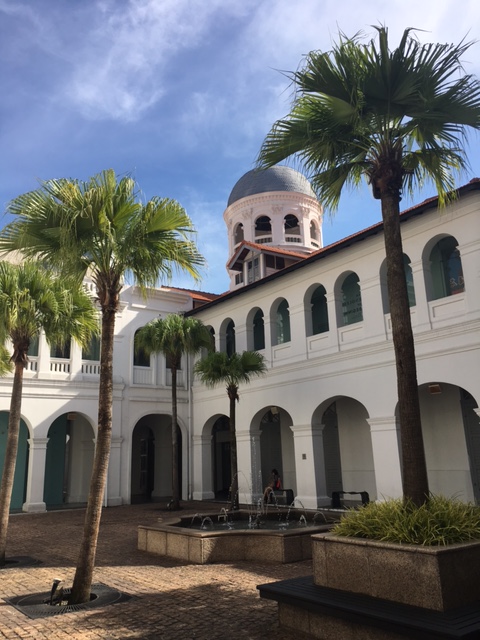The fifth Singapore Biennale had been on my list for a while. After a few trips away, I finally had a weekend in town and I took it as an opportunity to check it off my list.
Held across 8 venues, both inside and outside the traditional gallery spaces, the Singapore Biennale is an ambitious outpouring of works by 59 SouthEast Asian, South Asian, and East Asian artists. For the 2016 – 2017 Biennale, the theme was the rather nebulous ‘Atlas of Mirrors’, summed up by the curators as follows…
From where we are, how do we picture the world – and ourselves? In charting our way around the world, humankind has relied on instruments of vision as well as navigation. Atlases map and mirror our journeys of discovery and often make visible more than just physical terrains; driven by our needs and desires, they embolden us to venture into the unknown.
To be honest, the curatorial musings often felt a little over-thought and overworked. The sub-categorisation really did push the boundaries of the theme, with some being downright bizarre (case in point: ‘an everywhere of mirrorings’ and a ‘breath of wills’). These took away from the experience more than they added. Much better was to do away with all the steer and start experiencing the art directly – especially as there’s so much to experience, as well as see, in this show.
I spent the best part of a Saturday exploring Singapore Art Museum’s Biennale offerings, and so my top five are somewhat biased by location. But, with only a month left to go before the Biennale closes, these are the artworks that stayed with me long after I left the crowds.
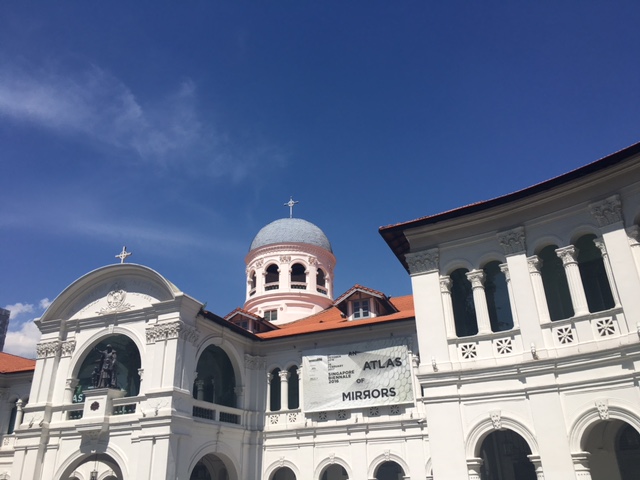
Martha Atienza, (Philippines), Endless Hours at Sea, 2014 – 2016
I have to admit: I tend to hate video art, or anything vaguely performative within a gallery. I once read a fantastic quotation by Waldemar Januszczak on this very topic, which sums up my general thoughts too:
Honestly, why should any of us watch any of this? At its best, it’s like turning the pages of someone else’s photo album whilst they drone on about their personal history.
Having said this, every so often I prove myself wrong (dammit), and come across a piece that really moves me. Atienza’s ‘Endless Hours at Sea’ is one of these.
Within a dark room are a variety of sound, light, image and water installation, charting journeys made by Atienza on cargo ships and using imagery and sounds from these travels.
The work is both restless and calming, like the seas it represents. I loved the piece with covered in water shimmering and rippling, every so often.
Tan Zi Hao, (Malaysia), The Skeleton of Makara (The Myth of a Myth), 2016
Ascending the stairs of the Art Museum, you are greeted by a large skeleton of what seems to be some sort of animal. It’s a sight you’d expect to see more in a natural history museum than a gallery.
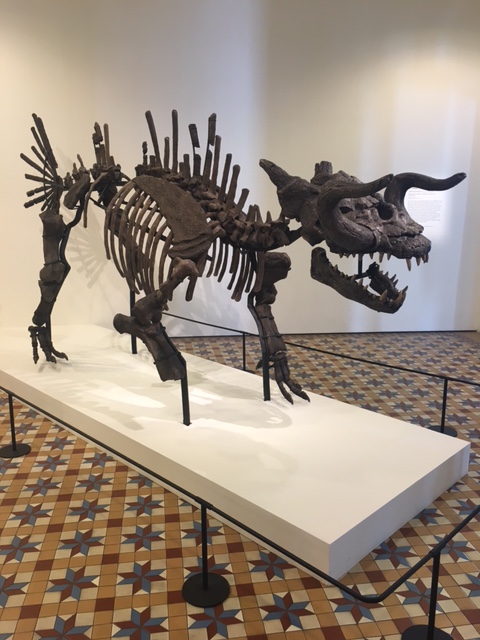
A closer look reveals too that the ‘animal’ is actually the mythical Hindu creature, Makara, a half-fish, half-mammal, common in South East Asian stories. In his artwork, Tan has created a fake historical artefact, and relic. There’s even some missing bones to make it more realistic.
I liked that this piece was literally about how art helps societies construct their history and identity, and, in this case, their myths.
Fyerol Darma, (Singapore), The Most Mild Mannered Men, 2016
A similar theme could be found in Fyerol Darma’s piece. This thought-provoking work is subtle; so subtle that you almost walk past it on your way through to the more eye-catching, shimmering artwork (‘History Repeats Itself’ by Titarubi).
A plinth with a bust of, essentially, an old white guy, occupies one side of the small passageway. So far, so museum.
Look closer, and the name of Stamford Raffles adorns the golden name bar on the plinth. So far, so Singapore.
It’s only when you stop to inspect the curatorial plaque, though, that you realise that this is only one half of the artwork. Opposite the plinth of Raffles is an identical wooden plinth, facing off against each other almost. Except, this plinth is empty, with Raffles left to stare at the void above the wooden column. The gold bar here is engraved ‘Sultan Hussein Mua’zzam Shah’.
This name, I must confess, is one I haven’t come across before in the year I’ve been in Singapore. And this is somewhat the point, with Shah being, along with Raffles, pivotal in the signing of two treaties that founded modern Singapore. Whilst Singapore is full of reminders of Sir Raffles (the eponymous hotel; roads; cultural markers), his less powerful counterpart largely goes without, physically and in the cultural imagination.
The use of statues within a national museum to make this point, only serves to reinforce Darma’s message, being typically establishment forms of bestowing cultural significance. Raffles is immortalised for Singapore; Shah is left a vague question mark.
I actually liked the fact that this artwork was so easy to walk-by: we are so immune to these cultural identifiers we don’t even stop to question them. It also speaks volumes on the wider status quo that tells us history is written by the winners: the rich and powerful get their plinths, plaques and statues; others are sidelined. As a relatively new arrival to Singapore it also gave me a good history lesson.
Deng Guoyuan, (China), Noah’s Garden II, 2016
This work is a truly experiential take on the Biennale’s artistic theme, allowing users to step into a literal kaleidoscope.
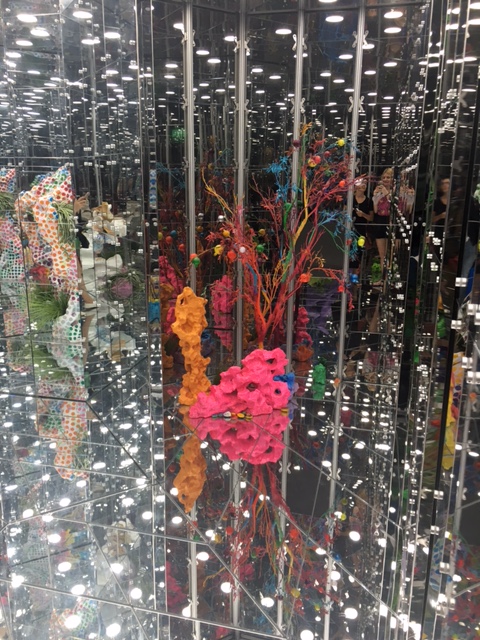
Entering the room, you’re surrounded by mirrored mosaics everywhere you look in various sizes – on the wall, ceiling, floor, with a rotating series of mirrors in the centre of the room. Twinkling lights everywhere reflect back onto each other and you’re confronted with various distortions of your own reflection and that of others inside the artwork
The organic and the manufactured sit side by side. Neon plastic trees and bushes are dotted around the artwork – it feels like an Alice in Wonderland scene: you’ve fallen down the rabbit hole. A mishmash of reality and imagination, after 5 minutes in the piece you feel quite disorientated and my friend joked that she couldn’t find her way back out
I loved that the piece invites interaction – literally by allowing you to get right inside the artwork, but also cannily by being a supremely instagrammable piece. Maybe too much interaction at some point – those with dresses and skirts were given sarongs by the gallery after some unintended upskirt shots!
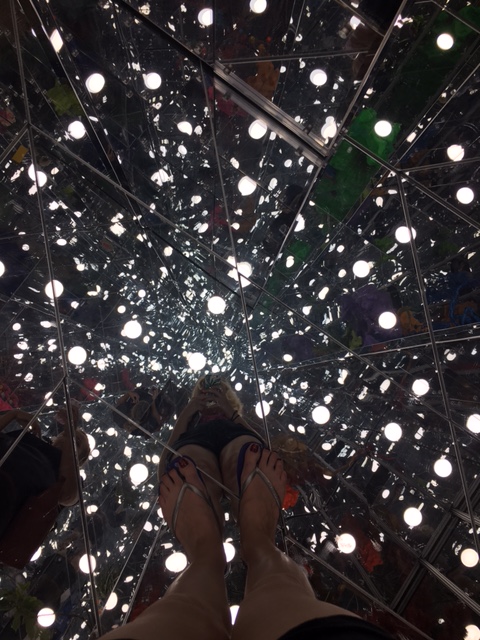
Qiu Zhijie, (China), One Has to Wander through All the Outer Worlds to Reach the Innermost Shrine at the End, 2016
This expansive work grabs your attention as soon as you walk in the large gallery it occupies. Two walls of the gallery are covered floor to ceiling with the most intricate maps. Below them sit various crystal animals on slate.
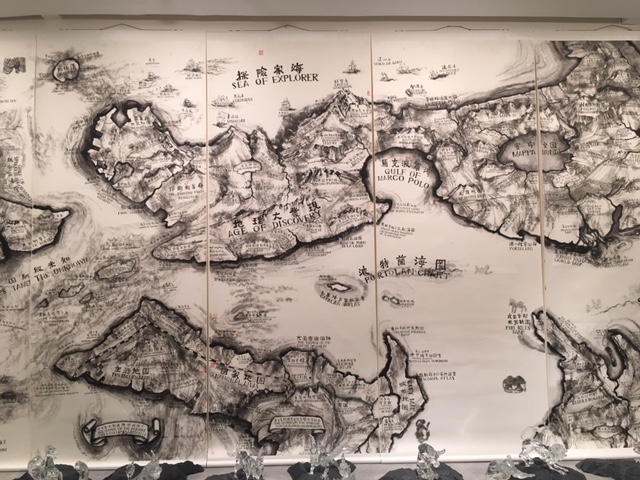
The maps themselves detail countries, continents, islands, and the seas between them; but these aren’t a real representation of the world. Instead they chart different myths, legends, philosophies, scientific ideas and historical moments. As well as the artwork being exquisitely presented, I also loved spotting the names chosen. I saw Lilliput, the Age of Discovery and the Gulf of Marco Polo.
Getting there
- Singapore Art Museum can be found at 71 Bras Basah Road, Singapore . Nearest MRTS are City Hall, Bugis and Dhoby Ghaut.
- Singapore Biennale 2016 is hosted across 8 different locations across the city, and runs until 26 February 2016.
